#online class help service
Explore tagged Tumblr posts
Text
Time Management Tips for Online Students with Busy Schedules
Online learning offers flexibility, but it also presents unique challenges, especially for students juggling multiple responsibilities. Without a structured approach, deadlines pile up, stress levels rise, and productivity dwindles. To succeed in a virtual academic environment, mastering time management tips for online students is essential. Implementing effective strategies can help learners stay organized, meet deadlines, and maintain a balanced lifestyle.
1. Establish a Structured Routine
Unlike traditional classrooms with fixed schedules, online courses demand self-discipline. Setting a consistent routine fosters stability and ensures academic responsibilities don't get sidelined. Dedicate specific hours for studying, attending lectures, and completing assignments. A well-structured plan prevents last-minute scrambles and enhances efficiency.
Wake up at a consistent time every day.
Designate a quiet study area.
Allocate breaks to prevent burnout.
2. Prioritize Tasks with the Eisenhower Matrix
Managing multiple assignments and deadlines can feel overwhelming. The Eisenhower Matrix categorizes tasks into four quadrants:
Urgent & Important – Complete these immediately.
Important but Not Urgent – Schedule for later.
Urgent but Not Important – Delegate if possible.
Neither Urgent nor Important – Eliminate or minimize.
By organizing tasks systematically, students can focus on high-impact activities and avoid unnecessary distractions.
3. Use Productivity Tools and Digital Planners
Technology can be a powerful ally in academic success. Leverage productivity tools like Trello, Asana, or Google Calendar to track assignments, deadlines, and virtual meetings.
Google Calendar – Set reminders for coursework and exams.
Pomodoro Technique Apps – Enhance focus with time-blocking strategies.
Note-taking Apps – Use Evernote or Notion to store class materials efficiently.
These digital resources simplify organization and ensure nothing slips through the cracks.
4. Minimize Distractions for Maximum Focus
A common pitfall of online learning is the ease of distractions. Social media notifications, household chores, and external noises can disrupt concentration. To maintain focus:
Turn off non-essential notifications during study hours.
Use website blockers like Freedom or Cold Turkey to limit digital distractions.
Invest in noise-canceling headphones or play white noise to enhance concentration.
Distraction-free environments significantly improve comprehension and retention rates.
5. Seek Assistance Through Online Class Support Services
Balancing work, family, and academics can be daunting. Sometimes, students need extra support to keep up with coursework. Utilizing online class help services can provide valuable academic assistance, ensuring deadlines are met without compromising quality.
Access expert guidance for complex subjects.
Get assistance with research and assignments.
Save time while maintaining academic integrity.
Leveraging external support helps students manage their workload without feeling overwhelmed.
6. Develop a Growth-Oriented Mindset
Time management is not just about schedules—it’s about mindset. A proactive, disciplined approach fosters resilience and academic success.
Embrace challenges as learning opportunities.
Set realistic goals and track progress.
Stay adaptable and refine strategies as needed.
A growth mindset keeps students motivated and prevents stagnation in their academic journey.
7. Balance Studies with Personal Well-Being
Academic success should not come at the expense of physical and mental health. Overloading schedules without downtime can lead to exhaustion and burnout.
Incorporate exercise into daily routines.
Practice mindfulness or meditation to reduce stress.
Ensure adequate sleep for cognitive function.
A well-balanced lifestyle enhances both academic performance and overall well-being.
8. Leverage Help with Online Class Platforms
When deadlines mount and time runs short, utilizing help with online class services can be a game-changer. These platforms offer support in various ways, allowing students to focus on learning while managing their schedules efficiently.
Assistance with coursework and exam preparation.
Professional tutoring for complex subjects.
Time-saving solutions for students with packed schedules.
Delegating tasks when necessary ensures students maintain productivity without compromising on quality.
Final Thoughts
Effective time management is the cornerstone of success for online students. By implementing structured routines, prioritizing tasks, minimizing distractions, and seeking online class help, students can navigate their academic journey with ease. Adopting proactive strategies ensures coursework remains manageable, stress levels stay low, and learning outcomes improve. With the right approach, even the busiest students can excel in their online education.
0 notes
Text
How Online Class Help Can Improve Time Management Skills for Students
In the fast-paced world of education, students often find themselves overwhelmed by the numerous demands on their time. From attending lectures to completing assignments and preparing for exams, managing time efficiently becomes a challenge. Thankfully, Online Class Help services are emerging as a valuable tool for students striving to balance their academic responsibilities. By providing tailored support and expert guidance, these services offer more than just assistance with coursework; they play a crucial role in honing time management skills.

The Role of Online Class Help in Time Management
Effective time management is an essential skill for academic success, and many students struggle to develop it on their own. Help with online class offers a structured approach to studying, enabling students to better prioritize their tasks. One of the key benefits of these services is that they offer personalized schedules, helping students allocate time efficiently across their academic workload.
For instance, tutors can break down complex assignments into manageable tasks, helping students avoid the anxiety that often accompanies deadlines. With a clear outline of what needs to be done and when, students gain more control over their study habits. This structure provides a steady framework for not just meeting deadlines but also for optimizing productivity.
Improved Focus and Efficiency
One of the most notable ways Online Class Help contributes to time management is by fostering enhanced focus. Students often face distractions, whether from social media, part-time jobs, or other personal commitments. These distractions can fragment their attention and make it challenging to complete assignments in a timely manner.
An Online Class Help Service removes many of these distractions by offering a dedicated, goal-oriented approach to studying. The support provided by experts ensures that students are always working toward their immediate academic objectives, without veering off course. This singular focus on specific tasks allows students to be more productive within shorter time frames, effectively improving their overall time management abilities.
Breaking Down Complex Tasks
Students frequently encounter assignments that seem overwhelming at first glance. Large research papers, projects, or even exams can appear insurmountable when viewed as a whole. However, Help with online class services excel at breaking these large tasks into smaller, manageable components. This practice of chunking tasks allows students to tackle their work step by step, fostering a sense of accomplishment and reducing procrastination.
By offering a roadmap for completing each stage of a task, these services help students understand the most efficient way to approach their assignments. This organized method not only ensures timely completion but also reduces stress, as students can see that their workload is more manageable than it initially appeared.
Mastering Scheduling and Deadlines
An essential aspect of time management is the ability to meet deadlines consistently. With Online Class Help, students can develop better scheduling habits. The service often includes setting specific deadlines for each portion of an assignment, along with reminders to keep students on track. These deadlines are often more realistic and achievable, which enhances students' ability to plan ahead.
Furthermore, tutors help students establish a routine that incorporates regular study sessions, ensuring that they stay ahead of their coursework. This consistent practice of sticking to a study schedule not only leads to better time management but also enhances the quality of the work produced.
Building Accountability and Discipline
One of the greatest benefits of Online Class Help Service is the sense of accountability it instills in students. When students have access to expert assistance, they are more likely to stay committed to their goals. Tutors encourage consistent progress, check in regularly on assignments, and provide feedback that helps students stay focused on their tasks.
This level of accountability ensures that students don't procrastinate, and they learn the importance of sticking to a schedule. As a result, students become more disciplined in managing their time and develop the habits necessary to succeed in both academic and professional settings.
Overcoming Procrastination
Procrastination is one of the biggest obstacles to effective time management. It often arises from feeling overwhelmed or unsure of where to begin. Help with online class addresses this issue by offering a clear starting point and actionable steps for students to follow. Tutors can guide students through the process, providing them with the confidence they need to begin their assignments rather than delaying them.
Moreover, the positive reinforcement that comes with completing each step of an assignment encourages students to stay on track, gradually reducing procrastination over time. As students see the progress they’re making, they feel more motivated to continue, creating a productive cycle that feeds into better time management.
Conclusion
In today’s educational landscape, Online Class Help services are more than just academic aids; they are powerful tools for enhancing time management skills. By providing structure, accountability, and expert guidance, these services help students prioritize their tasks, stay focused, and meet deadlines. As a result, students not only perform better academically but also develop lifelong skills that will serve them well in all areas of life. Whether it's breaking down complex tasks, overcoming procrastination, or mastering scheduling, Online Class Help Service is a valuable ally in the pursuit of academic and personal success.
0 notes
Text
How Does The Brain Work?

The brain stands as a marvel of biological engineering, Composing of a multitude of bodily functions ranging from cognition and memory to emotions and sensory perception. Together with the spinal cord, it constitutes the central nervous system (CNS), the command center of the human body.
Composition of the Brain
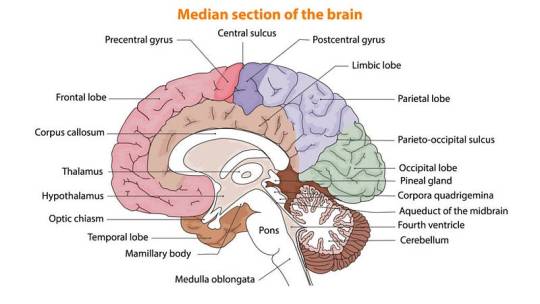
Weighing approximately 3 pounds in adults, the brain’s main structure comprises about 60% fat, interspersed with water, protein, carbohydrates, and salts. Unlike muscles, it houses a complex network of blood vessels and nerves, including neurons and glial cells.
a) Gray and White Matter
Within the central nervous system, gray matter and white matter occupies distinct regions. In the brain, gray matter forms the outer layer, rich in neuron somas, while white matter constitutes the inner section, primarily composed of axons unsheathed in myelin. Conversely, in the spinal cord, this arrangement is reversed.
b) Brain Functionality
The brain operates by transmitting and receiving chemical and electrical signals throughout the body. These signals regulate a myriad of processes, with the brain disseminating each input. Some signals remain confined within the brain, while others traverse the spinal cord and nerves, disseminating information across the body’s expanse. This composes neural network relies on billions of interconnected neurons.
Major Brain Regions and Their Functions
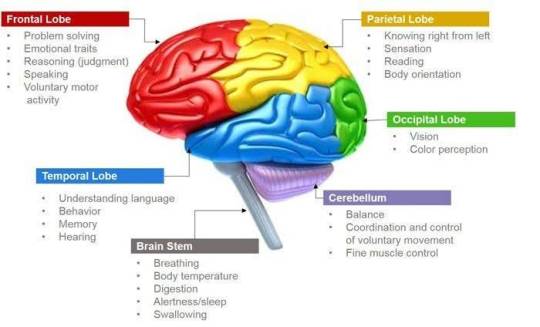
1.Cerebrum
Dominating the brain’s landscape, the cerebrum encompasses the cerebral cortex and underlying white matter. It governs a spectrum of functions, including motor coordination, temperature regulation, language processing, emotional regulation, and sensory perception.
2. Brainstem
Serving as the bridge between the cerebrum and spinal cord, the brainstem comprises the midbrain, pons, and medulla. It regulates vital autonomic functions such as heart rate, breathing, and reflexive responses.
3. Cerebellum
Nestled at the posterior aspect of the brain, the cerebellum coordinates voluntary muscle movements, posture, balance, and motor learning.
Brain Coverings
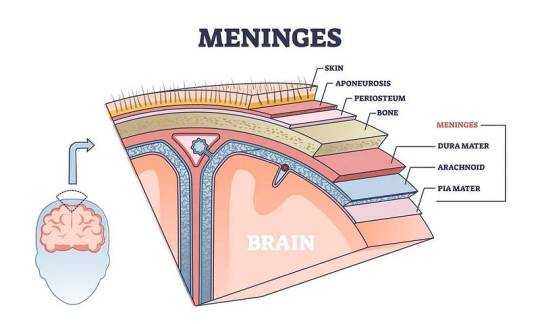
a) Meninges
Three layers of protective membranes, collectively known as meninges, enshroud the brain and spinal cord. These layers — dura mater, arachnoid mater, and pia mater — shield the delicate neural tissue from physical trauma and infection.
b) Lobes of the Brain
Each hemisphere of the brain comprises four lobes, each harboring distinct functional domains:
Frontal Lobe: Governing executive functions, motor control, and higher cognitive processes.
Parietal Lobe: Integrating sensory information, spatial awareness, and perception of pain and touch.
Occipital Lobe: Specialized for visual processing and perception.
Temporal Lobe: Involved in auditory processing, language comprehension, and memory consolidation.
Deeper Brain Structures
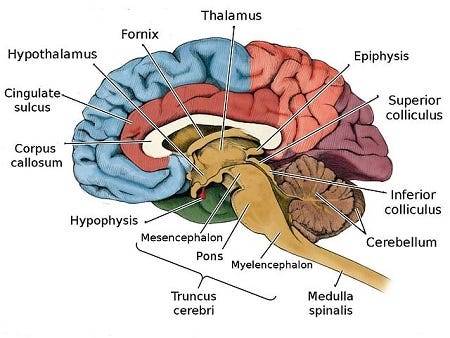
These encompass important structures such as the pituitary gland, hypothalamus, amygdala, hippocampus, and pineal gland, orchestrating hormone secretion, emotional regulation, memory consolidation, and circadian rhythms.
Blood Supply
The brain receives its oxygenated blood supply through the vertebral and carotid arteries, ensuring adequate perfusion of neural tissue. The main network of blood vessels, including the Circle of Willis, safeguards against ischemic insults and facilitates intraarterial communication.
Cranial Nerves
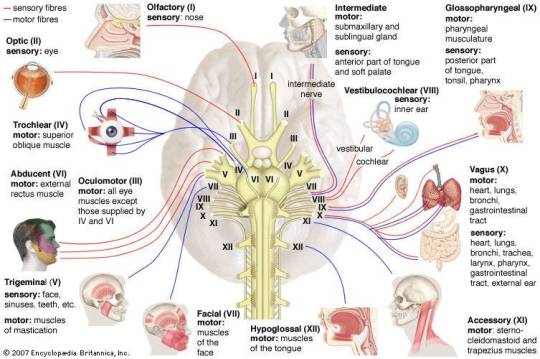
The twelve pairs of cranial nerves, originating from the brainstem, mediate a diverse array of sensory and motor functions, encompassing olfaction, vision, facial expression, and auditory perception.
Comprehending the anatomy and functionality of the brain fosters a deeper appreciation of its complexity and facilitates advances in neuroscientific research and therapeutic interventions aimed at diminishing neurological disorders.
Understanding the detailed anatomy and functionality of the brain is crucial for medical students embarking on their journey of study. Expert Academic Assignment Help offers invaluable assistance in navigating the complexities of neuroscience and related subjects. By leveraging expert guidance and support, students can excel in their medical education and contribute to advancements in the field of Medicine. Email us at [email protected] to embark on your path to scholarly excellence and professional competency.
#studying#studyblr#study blog#study aesthetic#student life#student#medical student#medical school#medicine#university student#university#university life#assignment help#medical students#nursing student#nursing school#healthcare#health and wellness#mental health#psychology#phd life#phd thesis writing service#online writing#do my online class#academic writing#essay writing#academic assignments#academia
15 notes
·
View notes
Text
25 ways to be a little more punk in 2025
Cut fast fashion - buy used, learn to mend and/or make your own clothes, buy fewer clothes less often so you can save up for ethically made quality
Cancel subscriptions - relearn how to pirate media, spend $10/month buying a digital album from a small artist instead of on Spotify, stream on free services since the paid ones make you watch ads anyway
Green your community - there's lots of ways to do this, like seedbombing or joining a community garden or organizing neighborhood trash pickups
Be kind - stop to give directions, check on stopped cars, smile at kids, let people cut you in line, offer to get stuff off the high shelf, hold the door, ask people if they're okay
Intervene - learn bystander intervention techniques and be prepared to use them, even if it feels awkward
Get closer to your food - grow it yourself, can and preserve it, buy from a farmstand, learn where it's from, go fishing, make it from scratch, learn a new ingredient
Use opensource software - try LibreOffice, try Reaper, learn Linux, use a free Photoshop clone. The next time an app tries to force you to pay, look to see if there's an opensource alternative
Make less trash - start a compost, be mindful of packaging, find another use for that plastic, make it a challenge for yourself!
Get involved in local politics - show up at meetings for city council, the zoning commission, the park district, school boards; fight the NIMBYs that always show up and force them to focus on the things impacting the most vulnerable folks in your community
DIY > fashion - shake off the obsession with pristine presentation that you've been taught! Cut your own hair, use homemade cosmetics, exchange mani/pedis with friends, make your own jewelry, duct tape those broken headphones!
Ditch Google - Chromium browsers (which is almost all of them) are now bloated spyware, and Google search sucks now, so why not finally make the jump to Firefox and another search like DuckDuckGo? Or put the Wikipedia app on your phone and look things up there?
Forage - learn about local edible plants and how to safely and sustainably harvest them or go find fruit trees and such accessible to the public.
Volunteer - every week tutoring at the library or once a month at the humane society or twice a year serving food at the soup kitchen, you can find something that matches your availability
Help your neighbors - which means you have to meet them first and find out how you can help (including your unhoused neighbors), like elderly or disabled folks that might need help with yardwork or who that escape artist dog belongs to or whether the police have been hassling people sleeping rough
Fix stuff - the next time something breaks (a small appliance, an electronic, a piece of furniture, etc.), see if you can figure out what's wrong with it, if there are tutorials on fixing it, or if you can order a replacement part from the manufacturer instead of trashing the whole thing
Mix up your transit - find out what's walkable, try biking instead of driving, try public transit and complain to the city if it sucks, take a train instead of a plane, start a carpool at work
Engage in the arts - go see a local play, check out an art gallery or a small museum, buy art from the farmer's market
Go to the library - to check out a book or a movie or a CD, to use the computers or the printer, to find out if they have other weird rentals like a seed library or luggage, to use meeting space, to file your taxes, to take a class, to ask question
Listen local - see what's happening at local music venues or other events where local musicians will be performing, stop for buskers, find a favorite artist, and support them
Buy local - it's less convenient than online shopping or going to a big box store that sells everything, but try buying what you can from small local shops in your area
Become unmarketable - there are a lot of ways you can disrupt your online marketing surveillance, including buying less, using decoy emails, deleting or removing permissions from apps that spy on you, checking your privacy settings, not clicking advertising links, and...
Use cash - go to the bank and take out cash instead of using your credit card or e-payment for everything! It's better on small businesses and it's untraceable
Give what you can - as capitalism churns on, normal shmucks have less and less, so think about what you can give (time, money, skills, space, stuff) and how it will make the most impact
Talk about wages - with your coworkers, with your friends, while unionizing! Stop thinking about wages as a measure of your worth and talk about whether or not the bosses are paying fairly for the labor they receive
Think about wealthflow - there are a thousand little mechanisms that corporations and billionaires use to capture wealth from the lower class: fees for transactions, interest, vendor platforms, subscriptions, and more. Start thinking about where your money goes, how and where it's getting captured and removed from our class, and where you have the ability to cut off the flow and pass cash directly to your fellow working class people
47K notes
·
View notes
Text
Finding the Best IB Tutors: A Complete Guide
Finding the best IB tutors is not a simply thing. because the International Baccalaureate (IB) Diploma Program is a rigorous and comprehensive curriculum designed to prepare students for higher education and global success. However, its demanding structure—including components like the Theory of Knowledge (TOK), Internal Assessments (IA), and Extended Essay (EE)—requires more than just classroom…
#Best IB Tutors#Biology SL tutoring#Excellent Home Classes#Extended Essay guidance#IB assessment criteria#IB core component tutoring#IB coursework help#IB exam preparation#IB exam strategies#IB past papers#IB personalized tutoring#IB study tips#IB subject-specific guidance#IB tutoring benefits#IB Tutoring Services#Mathematics HL tutoring#online IB tutors#TOK essay help#top IB tutoring platforms
0 notes
Text
Finding the Best IB Tutors: A Complete Guide
Finding the best IB tutors is not a simply thing. because the International Baccalaureate (IB) Diploma Program is a rigorous and comprehensive curriculum designed to prepare students for higher education and global success. However, its demanding structure—including components like the Theory of Knowledge (TOK), Internal Assessments (IA), and Extended Essay (EE)—requires more than just classroom…
#Best IB Tutors#Biology SL tutoring#Excellent Home Classes#Extended Essay guidance#IB assessment criteria#IB core component tutoring#IB coursework help#IB exam preparation#IB exam strategies#IB past papers#IB personalized tutoring#IB study tips#IB subject-specific guidance#IB tutoring benefits#IB Tutoring Services#Mathematics HL tutoring#online IB tutors#TOK essay help#top IB tutoring platforms
0 notes
Text
#Online Btech tuition#Engineering tuition online#Btech tutoring services#Virtual Btech classes#Online engineering coaching#Btech distance learning#Remote Btech tutoring#Virtual Btech tuition#Online engineering tutors#Btech coursework help#Btech exam preparation#Engineering subject tutoring#Online Btech degree assistance#Btech online learning support#Engineering homework help
0 notes
Text

#take my online quiz for me#isc help class 12 maths#math test helper#statistics homework help free#pay someone to take gre for me#university assignment helper#take my teas test for me#help me with my exam#homework help service#law assignment helper#accounting homework help online#take my nursing exam for me#math exam taker#take my accounting exam for me#computer science assignment helper
0 notes
Text
Challenges of Online Classes for Students and How to Overcome Them
Online learning has revolutionized education, offering students flexibility and accessibility like never before. However, this mode of learning is not without its difficulties. Many learners struggle with various obstacles that hinder their academic success. Understanding these challenges of online classes for students and implementing effective solutions can make a significant difference in performance and overall learning experience.
1. Lack of Discipline and Time Management
One of the most common challenges of online classes for students is the lack of structure compared to traditional classrooms. Without a set schedule, students may procrastinate, miss deadlines, or struggle to balance coursework with other responsibilities.
How to Overcome It
Create a Study Plan: Establish a routine with designated study hours to maintain consistency.
Use Digital Tools: Productivity apps like Trello, Notion, or Google Calendar can help organize tasks.
Set Priorities: Divide work into manageable chunks and tackle high-priority tasks first.
2. Technical Difficulties and Internet Connectivity Issues
A stable internet connection is essential for online learning. However, many students face connectivity issues, outdated devices, or software incompatibility, making it difficult to attend live sessions or submit assignments.
How to Overcome It
Ensure a Reliable Connection: Use wired connections when possible or invest in a good router.
Keep Backup Options: Download lectures and materials in advance to access them offline.
Seek Technical Assistance: Utilize online class help services that offer tech support or troubleshooting guidance.
3. Limited Interaction and Lack of Engagement
Online classes often lack the social engagement of physical classrooms, making it harder for students to stay motivated. The absence of direct peer interaction can lead to feelings of isolation.
How to Overcome It
Participate in Discussions: Engage in class forums, group chats, and virtual study groups.
Utilize Interactive Tools: Platforms like Zoom, Microsoft Teams, and Google Meet offer breakout rooms and collaborative features.
Seek External Support: Opt for help with online class services that provide tutoring and additional guidance.
4. Distractions and Home Environment Challenges
Studying from home presents numerous distractions, from social media to household noise. Without a dedicated learning space, students may struggle to concentrate.
How to Overcome It
Designate a Study Space: Choose a quiet, clutter-free area for studying.
Minimize Digital Distractions: Use website blockers to limit access to distracting content.
Set Boundaries: Communicate with family members to minimize interruptions during study hours.
5. Difficulty in Understanding Course Material
Some students find it challenging to grasp complex topics without face-to-face instruction. The lack of immediate clarification from instructors can lead to frustration and gaps in knowledge.
How to Overcome It
Utilize Additional Learning Resources: Watch video tutorials, read e-books, and explore academic forums.
Reach Out to Instructors: Email professors or attend virtual office hours for clarification.
Consider Professional Assistance: Enlisting online class help can provide expert guidance and academic support.
Conclusion
While the challenges of online classes for students are undeniable, they can be mitigated with the right strategies. Establishing discipline, leveraging technology, and seeking help with online class support services can transform the online learning experience into a successful endeavor. With perseverance and the right approach, students can thrive in digital education and achieve academic excellence.
#Online class Help#Help with online class#Take my online class#Online class Help service#Best online class Help service
0 notes
Text
How to Effectively Balance Work, Life, and Studies with Online Class Help
Balancing work, personal life, and studies has become a modern-day challenge for many individuals. With the increasing demands of professional responsibilities and family obligations, it can seem nearly impossible to find time for academic pursuits. Fortunately, Online Class Help provides a solution that can enable you to manage these competing priorities. By adopting strategic approaches and utilizing the right support, it’s possible to excel in your career, maintain a fulfilling personal life, and still perform well academically. Here’s how you can effectively balance all three with the assistance of Help With Online Class.

Prioritize Tasks and Set Realistic Goals
One of the first steps in maintaining a balance between work, life, and studies is to prioritize your tasks. By distinguishing between urgent and important tasks, you can ensure that you allocate your time wisely. Start by creating a daily or weekly schedule that clearly defines your work hours, personal activities, and study periods. This way, you can set realistic goals for what you need to accomplish without overwhelming yourself.
When it comes to studies, breaking down assignments and projects into manageable tasks can help you avoid procrastination and last-minute stress. Consider the deadlines for your classes and work backward to allocate time for each step of the assignment. Having a clear structure will allow you to stay on top of your commitments and avoid feeling like everything is a last-minute rush.
Embrace the Flexibility of Online Learning
One of the biggest advantages of online education is its flexibility. Unlike traditional classroom settings, online courses allow you to learn at your own pace and on your own schedule. This flexibility is especially beneficial when you’re juggling work and personal commitments. Whether you’re a full-time employee or a busy parent, you can schedule study sessions during breaks, evenings, or weekends to fit your routine.
However, this flexibility also comes with its challenges. Without the structure of in-person classes, it’s easy to fall into the trap of procrastination. To counter this, treat your online classes as seriously as you would a traditional class. Set up a dedicated study space, free from distractions, and stick to the schedule you’ve set for yourself. If time becomes too limited, Help With Online Class services can offer the extra support needed to stay on track.
Utilize Online Class Help for Efficient Learning
Even the most dedicated students can find themselves struggling to keep up with coursework when balancing multiple responsibilities. This is where Online Class Help becomes invaluable. Professional tutors and academic support services can offer personalized assistance, whether it’s helping you understand complex concepts, managing deadlines, or even completing assignments.
These services can save you time by providing expert guidance on subjects where you might feel less confident. Whether you need help with a particular assignment or general study tips, leveraging Help With Online Class allows you to focus on mastering the material, rather than getting bogged down by challenges that could otherwise hinder your progress. This external support ensures that you don’t sacrifice your academic performance, even when you’re balancing multiple priorities.
Use Time Management Tools
Effective time management is key to balancing work, life, and studies. To make the most of your limited time, consider using productivity tools like digital calendars, task management apps, and time-tracking software. These tools can help you allocate time for work, personal activities, and study sessions, ensuring that you don’t neglect any area of your life.
For instance, apps like Trello, Notion, or Google Calendar allow you to create detailed schedules and set reminders for upcoming tasks. By staying organized and visualizing your responsibilities, you can better manage your workload and make more informed decisions about where to allocate your time. These tools also allow you to break down larger projects into smaller, manageable tasks, making it easier to track progress.
Set Boundaries to Protect Your Well-being
Maintaining a balance between work, life, and studies is not just about productivity; it’s also about protecting your mental and physical health. Setting boundaries is crucial to ensuring that none of these areas overwhelm you. When it comes to work, communicate with your employer about the need for flexibility or time off if your academic commitments require more attention. Similarly, don’t be afraid to set aside time for personal activities, such as spending time with family, exercising, or engaging in hobbies that help you recharge.
Overworking yourself, whether at your job or in your studies, can quickly lead to burnout. Recognizing when you need a break and taking steps to rest is an essential component of long-term success. Online learning provides the opportunity to take short, effective breaks between study sessions. Incorporating self-care into your routine will ensure that you can perform well in all areas without sacrificing your health.
Seek Support When Needed
In today’s interconnected world, you don’t have to go it alone. If you ever feel overwhelmed, don’t hesitate to reach out for support. Whether it’s talking to a colleague or a mentor at work, confiding in family members, or seeking professional academic assistance, asking for help can provide relief and prevent you from becoming too stressed. Help With Online Class services are a valuable resource, allowing you to outsource certain aspects of your studies when time becomes tight.
Additionally, maintaining open communication with your employer and family members about your academic goals can help them understand your time constraints and offer their support as well. Whether it’s taking on extra tasks at work or giving you space to study, having a support system in place ensures that you’re not alone in managing your responsibilities.
Conclusion
Successfully balancing work, life, and studies requires a combination of discipline, time management, and strategic support. With the right tools and resources, such as Online Class Help and Help With Online Class, you can not only meet your academic goals but also maintain a healthy work-life balance. By prioritizing tasks, embracing flexibility, and seeking support when needed, you can confidently navigate the demands of modern life while achieving success in all areas.
0 notes
Text
The Pathophysiology Of Spondylitis
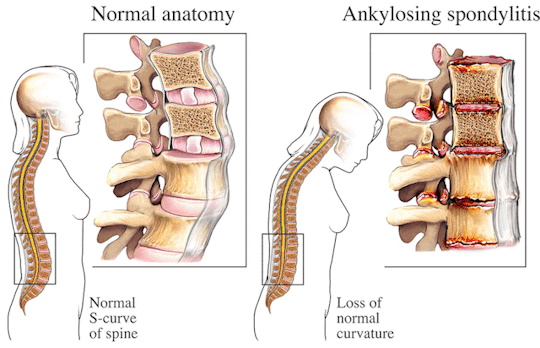
Spondylitis is a comprehensive term used to describe a group of chronic inflammatory diseases that primarily affect the joints of the spine and the sacroiliac region, which includes the pelvis and lower spine. These conditions are characterized by arthritis-like symptoms and can lead to significant discomfort, reduced mobility, and other systemic complications. This detailed exploration will indulge into the nature of spondylitis, how it differs from the related condition known as spondylosis, the various types of spondylitis, diagnostic methods, treatment options, and complementary therapies.
What is Spondylitis?

Spondylitis involves inflammation of the joints, tendons, and ligaments within the spine and sacroiliac region. Tendons are connective tissues that attach muscles to bones, while ligaments connect bones to other bones. This inflammation can result in the fusion of bones (ankylosis) and the formation of new bone, leading to stiffness and reduced flexibility in the spine. In severe cases, excessive bone growth can cause significant curvature of the spine, known as kyphosis.
Spondylitis vs. Spondylosis
While both spondylitis and spondylosis cause pain in the hip and back, they are distinct conditions with different etiologies and characteristics.
Spondylitis is an autoimmune disorder where the immune system mistakenly attacks the joints, causing inflammation, bone fusion, and excessive bone formation. This condition typically develops in teenagers and young adults and can affect multiple organs and systems within the body.
Spondylosis, on the other hand, is a degenerative condition associated with aging and the natural wear and tear of the spine. It involves the degeneration of spinal joints and discs, often accompanied by the formation of bone spurs (osteophytes). Spondylosis primarily affects older individuals, with more than 85% of people over the age of 60 experiencing this condition.
Types of Spondylitis

Medical professionals categorize spondylitis using two primary classification systems: the traditional system and the newer system. The traditional system recognizes six specific types of spondylitis, whereas the newer system categorizes spondylitis into two broad types based on the affected body region.
Traditional Spondylitis Classifications:
a) Ankylosing Spondylitis (AS)
Symptoms: Ankylosing spondylitis primarily affects the spine, causing symptoms such as fatigue, chronic back pain, stiffness, and inflammation in various areas of the body, including joints and tendons. Over time, the vertebrae may fuse, leading to reduced mobility and flexibility.
Causes: The exact cause of AS is unknown, but a strong genetic association exists with the HLA-B27 gene. Approximately 90% of individuals with AS carry this gene, although not all carriers develop the disease.
b) Reactive Arthritis
Symptoms: Reactive arthritis typically presents with a triad of symptoms including arthritis (swelling and pain in joints), conjunctivitis (inflammation of the eyes with a sticky discharge), and urethritis (genital and bladder inflammation with painful urination). However, not all patients exhibit all three symptoms.
Causes: often follows a gastrointestinal infection or a sexually transmitted infection (STI). The immune system overreacts to the initial infection, leading to inflammation and joint pain. The HLA-B27 gene is also strongly linked to ReA, with 30–50% of affected individuals carrying this gene.
c) Psoriatic Arthritis (PsA)
Symptoms: Psoriatic arthritis is associated with the inflammatory skin condition psoriasis. Symptoms include dactylitis (swelling in toes and fingers), changes in nails (such as pitting), eye pain, joint pain, reduced range of motion, and fatigue. PsA typically affects people aged 30–50.
Causes: PsA often follows psoriasis, but it can also develop in individuals without skin symptoms. There is a genetic predisposition to PsA, with at least 10% of the population inheriting genes that increase susceptibility to psoriasis and PsA.
d) Enteropathic Arthritis (EnA)
Symptoms
Enteropathic arthritis is linked to inflammatory bowel diseases (IBDs) such as ulcerative colitis and Crohn’s disease. Symptoms include abdominal pain, bloody diarrhea, and joint swelling and pain.
Causes
The precise cause of EnA is unclear, but it is associated with chronic inflammation in the bowel. This inflammation may allow bacteria to penetrate the bowel wall, triggering an immune response that leads to joint inflammation. The HLA-B27 gene is also linked to EnA.
d) Juvenile Spondyloarthritis (JSpA)
Symptoms
Juvenile spondyloarthritis begins in individuals aged 16 or younger and typically affects the leg joints. Symptoms include joint pain, tenderness, and bowel inflammation.
Causes
Similar to adult spondylitis, JSpA is often associated with the HLA-B27 gene. The exact cause remains unknown, but genetic and environmental factors likely play a role.
e)Undifferentiated Spondyloarthritis (USpA)
Symptoms
USpA is characterized by a variety of symptoms that do not fit neatly into a specific rheumatoid disorder. Symptoms may include persistent lower back pain, joint pain in small and large joints, heel pain, swelling in hands and feet, general stiffness, eye inflammation, rash, urinary tract symptoms, and intestinal inflammation.
Causes
The causes of USpA are diverse and not fully understood. It encompasses a range of symptoms that do not meet the criteria for other specific types of spondylitis.
Newer Spondylitis Categorizations
Peripheral Spondyloarthritis (pSpA)
Peripheral spondyloarthritis affects joints and tendons outside the spine and sacroiliac joints, such as the hands, wrists, elbows, shoulders, knees, ankles, and feet. It includes forms of spondylitis such as reactive arthritis, enteropathic arthritis, and undifferentiated arthritis.
2. Axial Spondyloarthritis (AxSpA)
Axial spondyloarthritis involves inflammation and pain in the pelvis and spine. This category covers a broad range of spondylitis types and includes individuals with and without sacroiliac joint fusion. AxSpA is further subdivided into non-radiographic AxSpA (without visible joint damage on X-rays) and radiographic AxSpA (visible joint damage).
Diagnosis
Diagnosing spondylitis involves abroad approach, combining physical examination, medical history, and various diagnostic tests. There is no single definitive test for spondylitis, making a comprehensive evaluation essential.
a) Physical Examination
During a physical examination, the doctor will assess the patient’s symptoms, medical history, and family history of autoimmune diseases such as psoriasis and spondyloarthritis. The examination may include evaluating joint tenderness, swelling, and range of motion.
b) Diagnostic Tests
Blood Tests: Blood tests can help identify markers of inflammation, such as elevated erythrocyte sedimentation rate (ESR) and C-reactive protein (CRP). Testing for the presence of the HLA-B27 gene can also provide valuable information, although not all individuals with spondylitis carry this gene.
Imaging Tests: Imaging techniques are crucial for diagnosing spondylitis and assessing the extent of joint and bone damage.
X-rays: X-rays can reveal changes in the spine and sacroiliac joints, such as joint fusion and bone spurs.
MRI Scans: MRI scans provide detailed images of soft tissues and can detect early signs of inflammation and joint damage that may not be visible on X-rays.
Ultrasound Scans: Ultrasound scans can be used to assess inflammation in peripheral joints and tendons.
Genetic Testing: Testing for the HLA-B27 gene can support the diagnosis, particularly in cases where clinical symptoms and imaging findings are inconclusive.
Treatment
While there is no cure for spondylitis, various treatments can help manage symptoms, reduce inflammation, and improve the patient’s quality of life. Treatment plans are often tailored to the individual’s specific symptoms and disease severity.
Medications
Nonsteroidal Anti-Inflammatory Drugs (NSAIDs): NSAIDs are commonly used to reduce inflammation and pain in spondylitis patients. Examples include ibuprofen and naproxen.
Corticosteroids: Corticosteroids, such as prednisone, can be prescribed for short-term use to control severe inflammation and pain.
Disease-Modifying Antirheumatic Drugs (DMARDs): DMARDs, including methotrexate and sulfasalazine, can help manage symptoms and slow disease progression in some types of spondylitis.
Biologic Agents: Biologic agents, such as tumor necrosis factor (TNF) inhibitors (e.g., adalimumab, etanercept) and interleukin-17 (IL-17) inhibitors (e.g., secukinumab), target specific components of the immune system to reduce inflammation and prevent joint damage.
Analgesics: Pain relievers, such as acetaminophen, may be used to manage pain when inflammation is not the primary issue.
Physical Therapy
Physical therapy plays a crucial role in managing spondylitis by improving and maintaining spine flexibility and overall mobility. Techniques may include:
Massage Therapy: Therapeutic massage can help reduce muscle tension, improve circulation, and alleviate pain.
Spinal Manipulation: Performed by a trained physical therapist or chiropractor, spinal manipulation can enhance mobility and reduce pain.
Exercises: Tailored exercise programs can help strengthen muscles, improve posture, and enhance flexibility. Stretching exercises are particularly beneficial for maintaining spine and joint flexibility.
Breathing Exercises: Breathing exercises are essential for individuals with ankylosing spondylitis, as the condition can affect chest expansion and respiratory function. These exercises help maintain normal lung function and prevent restrictive lung disease.
Surgery: Surgery is generally considered a last resort and is reserved for severe cases where conservative treatments have failed. Surgical options include:
Joint Replacement: For patients with severe joint damage, joint replacement surgery (e.g., hip or knee replacement) can restore function and relieve pain.
Spinal Surgery: In cases of severe spinal deformity or nerve compression, spinal surgery may be necessary to correct curvature and alleviate pressure on nerves.
Complementary Therapies
In addition to conventional treatments, complementary therapies can provide additional symptom relief and improve overall well-being. These therapies are often used alongside standard medical treatments.
Massage Therapy: Massage therapy can help reduce muscle tension, improve blood circulation, and alleviate pain and stiffness in the affected areas.
Relaxation Techniques: Techniques such as deep breathing, progressive muscle relaxation, and meditation can help manage stress and reduce pain perception.
Yoga: Yoga combines physical postures, breathing exercises, and meditation to improve flexibility, strength, and relaxation. Yoga can be particularly beneficial for maintaining spine flexibility and reducing pain.
Acupuncture: Acupuncture involves the insertion of thin needles into specific points on the body to stimulate the nervous system and promote natural pain relief and healing.
Cupping: Cupping is a traditional therapy that involves placing suction cups on the skin to improve blood flow and reduce muscle tension. It can be used to alleviate pain and stiffness in the back and other affected areas.
Summary
Spondylitis encompasses a range of chronic inflammatory diseases that affect the spine and sacroiliac region. It is characterized by autoimmune-driven inflammation, leading to joint pain, stiffness, and potential bone fusion. Spondylitis is distinct from spondylosis, a degenerative condition associated with aging. Medical professionals classify spondylitis into various types based on symptoms and affected body regions. Diagnosis involves a combination of physical examination, medical history, blood tests, imaging, and genetic testing. While there is no cure, treatments such as medications, physical therapy, and complementary therapies can help manage symptoms and improve the quality of life for those affected by spondylitis. By understanding the nature of spondylitis and the available management strategies, individuals can better navigate their condition and maintain an active, fulfilling life.
Medical students and healthcare professionals need to stay informed about the latest advancements in diagnosing and treating spondylitis. Continuous education and expert guidance are crucial for managing these complex conditions. For additional support with challenging medical units, clinical studies, research projects, assignments, and exam preparation, Expert Academic Assignment Help offers professional resources and online classes. For personalized assistance, contact [email protected] Accessing expert guidance can significantly enhance your understanding and proficiency in medical education.
#medical students#assignment help#nursing school#nursing student#medicine#healthcare#student life#medical student#studyblr#case study#student#online writing#do my online class#essay writing#phd research#clinical research#research#phd thesis writing service#phdjourney#phd life#phdblr#studying#study blog#study motivation#studyspo#study aesthetic
5 notes
·
View notes
Text
Unlocking Success: Online Class Help Services in the USA
In today's fast-paced digital era, online education has become increasingly popular. As students and professionals seek the flexibility to balance their academic pursuits with work and personal commitments, the demand for online classes has surged. However, the challenges of managing online coursework, assignments, and exams can be overwhelming. This is where online class help services in the USA come to the rescue.
Online class help services are specialized platforms designed to assist students with their online courses, ensuring they meet their academic goals without the stress and time constraints typically associated with e-learning. These services have gained considerable popularity in the United States, thanks to the numerous advantages they offer.
Expert Assistance:
Online class help services connect students with experienced professionals who excel in various academic disciplines. Whether you need assistance in mathematics, science, humanities, or business studies, these services offer specialized experts who can navigate your online coursework and deliver top-quality work.
Time Management:
Balancing online classes with a busy life can be challenging. Online class help services allow students to reclaim their time, ensuring that they can focus on other essential aspects of their lives without compromising their education. This not only reduces stress but also enhances overall well-being.

Enhanced Performance:
The experts from these services are well-versed in the nuances of online education platforms, making them adept at maximizing performance. They can complete assignments, participate in discussions, and ace exams, boosting your grades and academic performance.
Plagiarism-Free Work:
Maintaining academic integrity is crucial. Online class help services guarantee original, plagiarism-free work, providing students with peace of mind knowing their assignments are not only well-researched but also ethically sound.
Confidentiality:
Worried about your privacy? Online class help services prioritize the confidentiality of their clients. You can trust them to protect your personal information and academic details.
Cost-Efficiency:
Many online class help services offer competitive pricing. When you consider the benefits of expert assistance, time saved, and improved grades, the cost is often a worthwhile investment in your future.
Flexibility:
Online class help services are available 24/7, offering flexibility to students who may need assistance at any time, whether it's a last-minute assignment or an urgent exam.
In conclusion, online class help services in the USA have emerged as invaluable resources for students seeking to excel in their online courses. With expert assistance, time management, and enhanced academic performance, these services are a beacon of hope in the rapidly evolving landscape of online education.
0 notes
Text
How can you make Money with your 2H Ruler

Picture found on Pinterest ♡︎ Content from @uyuforu
₍^. .^₎⟆ The 2H in Astrology is about our money, and often if we want to know how we can make money, we can check the ruler of this house and where it falls in our chart. Modern & Traditional rulers can be used. Example: 2H Ruler is in Aries, Aries is ruled by Mars, so we are gonna check where in your chart Mars fall.
₍^. .^₎⟆ Rulers:
Aries: Mars Taurus: Venus Gemini: Mercury Cancer: Moon Leo: Sun Virgo: Mercury Libra: Venus Scorpio: Mars & Pluto Sagittarius: Jupiter Capricorn: Saturn Aquarius: Saturn & Uranus Pisces: Jupiter & Neptune

⏦゚♡︎ 2H Ruler in 1H: Making money with your appearance, making money with your ideas, making money with a certain body part (yeah lol), making money based on products for the body, making money on your own, making money with your own company or business, etc.
⏦゚♡︎ 2H Ruler in 2H: Making money by investing, working hard, creating your own business or company, having money with possessions, making money with your job & career, etc.
⏦゚♡︎ 2H Ruler in 3H: Making money with your mind, with your ideas, with your words, making money with books, music, social medias, making money on the internet, with TV, with your hobby, with your siblings, with your neighbors, etc.
⏦゚♡︎ 2H Ruler in 4H: Making money with your home, family, your mother, with homes, real estate, with femininity, childhood, memories, nostalgia, emotions, a family business, making money with self care, etc.
⏦゚♡︎ 2H Ruler in 5H: Making money with a hobby, making money with friends, having a business with friends, making money with relationships, romance, love, making money with something fun, creative, making money with something about children, making money with self expression, etc.
⏦゚♡︎ 2H Ruler in 6H: Making money from self care, health, making money from helping others, making money by working hard, making money from your job, career, making money with fitness, making money with services, etc.
⏦゚♡︎ 2H Ruler in 7H: Making money with marriage, Spouse giving you money, getting money from marriage, making money with spouse, making money from haters & enemies, making money from contracts, making money from business or business partners, etc.
⏦゚♡︎ 2H Ruler in 8H: Making money with "endings", making money with other's money, making money with investments, making money with services, making money with spirituality, esotericism, making money with intimacy, making money with the physical body, making money with loans, real estate, possessions, assets, etc.
⏦゚♡︎ 2H Ruler in 9H: Making money with knowledge, making money with classes, with tourism, travels, making money with the act of learning, with schools, with languages, making money with cultures, making money with spirituality or religion, making money with grand parents, In-Laws, etc.
⏦゚♡︎ 2H Ruler in 10H: Making money with hard work, making money with your job or career, making money on the long run, making money with your business or company, making money with your father, a masculine figure, making money with masculinity, making money based on your reputation with fame, etc.
⏦゚♡︎ 2H Ruler in 11H: Making money on social medias, with social medias, with internet, on internet, making money with friends, having business or company with friends, online, making money to help others, making money with technologies, etc.
⏦゚♡︎ 2H Ruler in 12H: Making money with spirituality, with Esotericism, making money with religion, making money with foreign things, with the act of "ending", with healing, with self-care, making money with services, making money with hidden knowledge or things, etc.

₍^. .^₎⟆ BOOK A READING
Current February Sales
email address: [email protected]
Soft To You presentation and Q&A ᡣ𐭩 rules ᡣ𐭩 private readings reviews
astrology menu ᡣ𐭩 tarot menu ᡣ𐭩 special astrology & tarot readings
#astrology#astro#astro observations#astrology observations#astro community#astrology signs#astro notes#astro blog#astro reading#astro tumblr#astro placements#advanced astrology#astroblr#astrology blog#birth chart#astrology community#astrology notes#astrology readings
1K notes
·
View notes
Text
autism awareness & autism acceptance not either or. not mutually exclusive. can coexist. need coexist.
“there enough awareness for autism already 🙄 we need acceptance”
ok. you aware of high support needs autism? aware what that even means? not “need reminder take meds need remind take shower” “high” support needs autism, but “need full physical help do bADLs lack danger awareness may accidentally hurt self or even kill self without support” high support needs autism? not just higher support needs people who can be independently online do advocacy, but those who need help from others even be online, or those who cannot be online at. all.?
aware of nonverbal nonspeaking people? not just nonverbal nonspeaking people who can write grammatically correct cannot tell apart base on writing. not just nonverbal nonspeaking people who can be online who can advocate online.
aware of nonverbal nonspeaking people who cannot communicate in way that easily understood, either for now, or ever? aware of nonverbal nonspeaking people without functional communication, aware of how without functional communication, how that drastically limit communication, even though behaviors are valid communication? aware of nonverbal nonspeaking people who may never use AAC fluently even with best support?
aware of technically verbal but very limited verbal autistics who may only able say wants & needs but not other things and certainly not online advocacy, “despite being verbal”?
aware of just how much our life depends on caregiver/carer/PCA/etc? aware how vulnerable that make us? aware of abuse from caregivers? aware of caregiver burnout from lack of support for caregivers, & how that impact our care we receive? have you even heard of term respite care? aware of those of us who cannot separate ourselves from caregiver? aware of those of us who cannot participate in autism community without caregiver?
aware of visibly autistic people? aware how we not automatically believed? aware how we often bear blunt of violence because we most easily identified target because we visible? aware visible =/= get support, aware that many those diagnosed severe who now adult so no longer qualify for services under 21 year old, languish in hospitals because nowhere to go? aware how long life saving necessary waitlists are? aware that even to this day parents have to fight school fight day service fight government fight insurance for them give their nonverbal nonspeaking child AAC & be properly taught how use it? actually, are you aware of how properly teach AAC to nonverbal nonspeaking, developmentally delayed child who may or may not have intellectual disability?
actually, aware of autistics with (correctly diagnosed) intellectual disability & how they make up big amount of autistic? aware of institutional systemic & legal impact of mental [r word] right & the human rights abuse justified using r word right? wait, you aware that r word come from old term for intellectual disability, that, actually, still in many laws because no one bothered updating, right? aware of what severe profound ID look like? and aware they real and they still human deserve education deserve life deserve care, yes?
aware of early diagnosis 20 30 or even 10 years ago, not same as now, even less resources & knowledge about autism now? aware that while gender race class 1000% impacted diagnoses, a lot of early diagnosed people early diagnosed because… they die without support unlocked by diagnosis, right? but also, aware that in old times, early diagnosis often did mean doom, not because autism bad or anything, but because severe lack of support & diagnosis can literally bar you from so many things including basic education?
aware that for many people in special education, which impact specific group of autistic people, they not get degree when graduate high school, they just get certificate, which limit their educational & employment opportunities & others?
aware of life saving importance and necessity of masking for autistic of color especially Black autistic people, despite stress inducing traumatic? aware that live in broken system be victim of hate crime & police brutality just as traumatic often even more traumatic than masking? aware that many Black & other parents of color forced to teach their child masking because of this?
are you aware of most marginalized autistic people? aware of leadership of most impacted?
aware you can and need to care about autistic experiences & form of autism you not experience? aware that you can and need to do that without try twist your experience into our experience into our words our community?
aware that advocacy goes beyond about you?
aware that you can’t speak for all autistic? aware that you shouldn’t speak for all autistic?
are you aware of when you need to stop talking & listen & amplify others? aware of when and how to decenter self?
aware that even this long post, barely scratch surface? still so much to say?
[better worded version of original post]
#loaf screm#actually autistic#autism acceptence month#autism awareness#autism awareness month#high support needs#long post#nonverbal#nonspeaking#autism#autistic#autism acceptance
2K notes
·
View notes
Text
#Online Btech tuition#Engineering tuition online#Btech tutoring services#Virtual Btech classes#Online engineering coaching#Btech distance learning#Remote Btech tutoring#Virtual Btech tuition#Online engineering tutors#Btech coursework help#Btech exam preparation#Engineering subject tutoring#Online Btech degree assistance#Btech online learning support#Engineering homework help
1 note
·
View note
